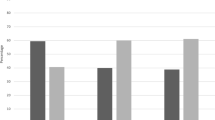Abstract
This study aimed to investigate the long-term outcomes of the surgical combination of revascularization and penile corrective techniques after having obtained promising preliminary results from a previous study. Between 2008 and 2015, the combined treatment was undertaken for 60 patients with Peyronie’s disease and erectile dysfunction. A preoperative urological evaluation was performed with penile color Doppler ultrasonography, electromyography of the corpus cavernosum and cavernosometry. All the patients completed 15-item and 5-item IIEFs preoperatively and at postoperative follow-up. The mean age of the patients was 53.78 ± 6.48 years ranging from 47 to 63. The mean follow-up period was 48 (14–68) months. The degree of penile angulation was >40 in all the patients. Urethra dissection was required in five patients. Penile disassembly was performed on one patient due to distal complex corporeal deformity. None of the patients reported complications after surgery. The mean total IIEF score was reported to be 25.4 ± 2.8 before the operation and 52.23 ± 1.2 at the end of the follow-up (p < 0.05). The mean IIEF-5 score was 7.3 ± 1.3 preoperatively and 20.9 ± 1.9 at the end of follow-up (p < 0.05). The results of IIEF-15 for erectile function demonstrated that 32 patients had a cutoff value of >26, indicating no ED. Although all patients had complete penile straightening, 7 (11.66%) reported shortening of the penis but was not dissatisfied with the treatment. The number of patients satisfied with the outcomes of the operation was 53. The statistically significant improvement and satisfactory results achieved with the IIEF questionnaires suggest that the proposed combined treatment could be an alternative to penile prosthesis in highly selected patients with Peyronie’s disease, particularly those with erectile dysfunction; however, more studies are needed to confirm these results.
This is a preview of subscription content, access via your institution
Access options
Subscribe to this journal
Receive 8 print issues and online access
$259.00 per year
only $32.38 per issue
Buy this article
- Purchase on Springer Link
- Instant access to full article PDF
Prices may be subject to local taxes which are calculated during checkout




Similar content being viewed by others
References
Kayigil O, Okulu E. The combination of penile revascularization surgery with penile corrective techniques as an alternative to prosthesis implantation in patients with Peyronie’s disease having ED: Preliminary results. IJIR 2013;25:166–71.
Kayigil O, Okulu E, Aldemir M, Onen E. Penile revascularization surgery in vasculogenic erectile dysfunction (ED): Long erm follow-up. BJU Int 2012;109:109–15.
Kayigil O, Agras K, Aldemir M, Okulu E. The combination of vein grafting and two different types of corporeal plication in complex curvature due to Peyronie’s disease. Urol Int 2010;84:275–81.
Furlow WL, Fisher J, Knoll LD. Current status of penile revascularization with deep dorsal vein arterialization: experience with 95 patients. Int J Impot Res 1990;2(Suppl 2):348.
Kayıgil O, Ahmed SI, Metin A. Deep dorsal vein arterialization in pure caverno-occlusive dysfunction. Eur Urol 2000;37:345–59.
Rosen RC, Riley A, Wagner G, Osterloh IH, Kirkpatrick J, Mishra A. The International Index of erectile function (IIEF). A multidimensional scale for assessment of erectile function. Urology 1997;49:822–30.
Raz S, De Kernion JB, Kaufman JJ. Surgical treatment of Peyronie’s disease: a new approach. J Urol 1977;117:598.
Knoll LD, Furlow WL, Benson RC Jr. Management of Peyronie disease by implantation of inflatable penile prosthesis. Urology 1990;36:406–9.
Rahman NU, Carrion RE, Bochinski D, Lue TF. Combined penile plication surgery and insertion of penile prosthesis for severe penile curvature and erectile dysfunction. J Urol 2004;171(6 Pt 1):2346–9.
Kayıgil O, Agras K, Metin A. Relaxation degree of cavernous smooth muscle: a novel parameter to predict postoperative success in penile revascularization. In Urol Nephrol 2007;39:1203–8.
Manning M, Junemann KP, Scheepe JR, Braun P, Krautschick A, Alken P. Long-Term follow-up and selection criteria for penile revasculazation in erectile failure. J Urol 1998;160:1680–4.
Kropman RF, Schipper JV, van Oostayen JA, Lycklama A, Nijeholt AA, Meainhardt W. The value of increased end diastolic velocity during penile duplex sonography in relation to pathological venous leakage in erectile dysfunction. J Urol 1992;148:314–7.
Kim SC, Moon YT, Oh CH. Non- visualization versus normal appearance of cavernous arteries on selective internal pudendal pharmaco-angiograms: comparison with duplex scanning, cavernosal artery systolic occlusion pressure and penile brachial index. Br J Urol 1994;73:185–9.
Kayigil O, Atahan O, Metin A. Electrical activity of the corpus cavernosum in patients with corporal veno-occlusive dysfunction. Br J Urol 1996;77:261–5.
Kayigil O, Atahan O, Metin A. Electromyographic changes of corpus cavernosum due to papaverine and nitroprusside in veno-occlusive dysfunction. J Urol 1996;156:1316–9.
Kayigil O, Ergen A. Caverno-occlusive and autonomic dysfunction: a new concept in young patients. Eur Urol 1998;34:124–7.
Zumbe J, Drawz G, Wicdemann A, Grozinger K, Engelmann U. Indications for penile revascularization and long term results. Andrologia 1999;31:83–87.
Vardi Y, Gruenwald I, Gedalia U, Nessar S, Engel A, Har-Shai Y. Evaluation of penile revascularization for erectile dysfunction: a 10 year follow-up. Int J of Impot Res 2004;16:181–6.
Kawanishi Y, Kimura K, Nakanishi R, Kojima K, Numata A. Penile revascularization surgery for arteriogenic erectile dysfunction: the long-term efficacy rate calculated by survival analysis. BJU Int 2004;94:361–8.
Author information
Authors and Affiliations
Corresponding author
Ethics declarations
Conflict of interest
The authors declare that they have no competing interests.
Rights and permissions
About this article
Cite this article
Kayigil, O., Okulu, E., Akdemir, F. et al. The combination of penile revascularization surgery with penile corrective techniques as an alternative to prosthesis implantation in patients with peyronie’s disease accompanied by erectile dysfunction: Long-term results. Int J Impot Res 30, 71–78 (2018). https://doi.org/10.1038/s41443-017-0012-4
Received:
Revised:
Accepted:
Published:
Issue Date:
DOI: https://doi.org/10.1038/s41443-017-0012-4


